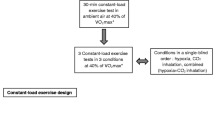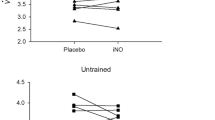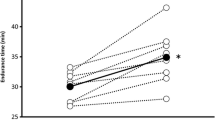Abstract
The reduced arterial oxygen tension at high altitude impairs the ability to work. Acetazolamide improves arterial oxygen saturation (SaO2) by increasing ventilation but is associated with an increased work and cost of breathing. Depending on the settings, sildenafil can also increases SaO2 possibly through a reduction in pulmonary hypertension and interstitial edema, which could improve ventilation–perfusion matching. The objective of this study is to determine the effects of acetazolamide and sildenafil on ventilatory control and breathing efficiency (V E/VCO2) during submaximal steady-state hypoxic exercise in healthy individuals. Following 18 h of hypoxic exposure in an altitude tent at an oxygen concentration of 12.5% (simulated altitude of 4,300 m), 15 participants performed 10 min of hypoxic exercise on a stationary bicycle at 40% of their sea level peak oxygen uptake (VO2) while randomly receiving sildenafil 40 mg (SIL), acetazolamide 125 mg (ACZ) or a placebo (PLA). There was no difference in VO2 during exercise between conditions while SaO2 was greater with acetazolamide compared to both placebo and sildenafil. Acetazolamide increased ventilation (PLA 49.0 ± 3.2, SIL 47.7 ± 3.1, ACZ 52.1 ± 3.0 l/min) and reduced end-tidal CO2 (P ETCO2) (PLA 32.1 ± 0.8, SIL 32.8 ± 0.9, ACZ 29.2 ± 0.7 mmHg) compared to placebo and sildenafil. Breathing was less efficient with acetazolamide (increased V E/VCO2) in comparison to placebo and sildenafil (PLA 41.5 ± 1.0, SIL 40.4 ± 1.3, ACZ 45.4 ± 1.0) while sildenafil did not change V E/VCO2 during hypoxic exercise. In conclusion, acetazolamide increased ventilation and reduced breathing efficiency while sildenafil did not affect breathing efficiency despite a trend toward a blunted ventilatory response, possibly due to a reduction in pulmonary hypertension and/or ventilatory drive, during submaximal hypoxic exercise in healthy individuals.



Similar content being viewed by others

References
Bocchi EA, Guimaraes G, Mocelin A et al (2002) Sildenafil effects on exercise, neurohormonal activation, and erectile dysfunction in congestive heart failure: a double-blind, placebo-controlled, randomized study followed by a prospective treatment for erectile dysfunction. Circulation 106:1097–1103. doi:10.1161/01.CIR.0000027149.83473.B6
Capen RL, Wagner WW Jr (1982) Intrapulmonary blood flow redistribution during hypoxia increases gas exchange surface area. J Appl Physiol 52:1575–1580
Dempsey JA, Gledhill N, Reddan WG et al (1977) Pulmonary adaptation to exercise: effects of exercise type and duration, chronic hypoxia and physical training. Ann NY Acad Sci 301:243–261. doi:10.1111/j.1749-6632.1977.tb38203.x
Faoro V, Huez S, Giltaire S et al (2007a) Effects of acetazolamide on aerobic exercise capacity and pulmonary hemodynamics at high altitudes. J Appl Physiol 103:1161–1165. doi:10.1152/japplphysiol.00180.2007
Faoro V, Lamotte M, Deboeck G et al (2007b) Effects of sildenafil on exercise capacity in hypoxic normal subjects. High Alt Med Biol 8:155–163. doi:10.1089/ham.2007.1058
Fulco CS, Rock PB, Cymerman A (1998) Maximal and submaximal exercise performance at altitude. Aviat Space Environ Med 69:793–801
Garske LA, Brown MG, Morrison SC (2003) Acetazolamide reduces exercise capacity and increases leg fatigue under hypoxic conditions. J Appl Physiol 94:991–996
Ghofrani HA, Reichenberger F, Kohstall MG et al (2004) Sildenafil increased exercise capacity during hypoxia at low altitudes and at Mount Everest base camp: a randomized, double-blind, placebo-controlled crossover trial. Ann Intern Med 141:169–177
Greene R (1934) Observations on the composition of alveolar air on Everest, 1933. J Physiol 82:481–485
Guazzi M, Tumminello G, Di Marco F et al (2004) The effects of phosphodiesterase-5 inhibition with sildenafil on pulmonary hemodynamics and diffusion capacity, exercise ventilatory efficiency, and oxygen uptake kinetics in chronic heart failure. J Am Coll Cardiol 44:2339–2348. doi:10.1016/j.jacc.2004.09.041
Hackett PH, Roach RC (2001) High-altitude illness. N Engl J Med 345:107–114. doi:10.1056/NEJM200107123450206
Hackett PH, Roach RC, Harrison GL et al (1987) Respiratory stimulants and sleep periodic breathing at high altitude. Almitrine versus acetazolamide. Am Rev Respir Dis 135:896–898
Hsu AR, Barnholt KE, Grundmann NK et al (2006) Sildenafil improves cardiac output and exercise performance during acute hypoxia, but not normoxia. J Appl Physiol 100:2031–2040. doi:10.1152/japplphysiol.00806.2005
Jonk AM, van den Berg IP, Olfert IM et al (2007) Effect of acetazolamide on pulmonary and muscle gas exchange during normoxic and hypoxic exercise. J Physiol 579:909–921. doi:10.1113/jphysiol.2006.120949
Kjaergaard J, Snyder EM, Hassager C et al (2007) Right ventricular function with hypoxic exercise: effects of sildenafil. Eur J Appl Physiol 102:87–95. doi:10.1007/s00421-007-0560-2
Kleber FX, Vietzke G, Wernecke KD et al (2000) Impairment of ventilatory efficiency in heart failure: prognostic impact. Circulation 101:2803–2809
Kolluru GK, Tamilarasan KP, Rajkumar AS et al (2008) Nitric oxide/cGMP protects endothelial cells from hypoxia-mediated leakiness. Eur J Cell Biol 87:147–161. doi:10.1016/j.ejcb.2007.10.001
Lake Louise consensus on definition and quantification of altitude illness. (1992) In: Hypoxia: mountain medicine. Queen City Press, Burlington, Vermont, pp 327–330
Lewis GD, Lachmann J, Camuso J et al (2007) Sildenafil improves exercise hemodynamics and oxygen uptake in patients with systolic heart failure. Circulation 115:59–66. doi:10.1161/CIRCULATIONAHA.106.626226
McLellan T, Jacobs I, Lewis W (1988) Acute altitude exposure and altered acid-base states. I. Effects on the exercise ventilation and blood lactate responses. Eur J Appl Physiol Occup Physiol 57:435–444. doi:10.1007/BF00417990
Milic-Emili J, Grunstein MM (1976) Drive and timing components of ventilation. Chest 70:131–133
Rahn H, Otis AB (1948) Man’s respiratory response during acclimatization to high altitude. Fed Proc 7:96
Reichenberger F, Kohstall MG, Seeger T et al (2007) Effect of sildenafil on hypoxia-induced changes in pulmonary circulation and right ventricular function. Respir Physiol Neurobiol 159:196–201. doi:10.1016/j.resp.2007.07.005
Ricart A, Maristany J, Fort N et al (2005) Effects of sildenafil on the human response to acute hypoxia and exercise. High Alt Med Biol 6:43–49. doi:10.1089/ham.2005.6.43
Richalet JP, Gratadour P, Robach P, et al (2005) Sildenafil inhibits altitude-induced hypoxemia and pulmonary hypertension. Am J Respir Crit Care Med 171:275–281
Roberts AM, Bhattacharya J, Schultz HD et al (1986) Stimulation of pulmonary vagal afferent C-fibers by lung edema in dogs. Circ Res 58:512–522
Schoene RB, Bates PW, Larson EB et al (1983) Effect of acetazolamide on normoxic and hypoxic exercise in humans at sea level. J Appl Physiol 55:1772–1776
Sebkhi A, Strange JW, Phillips SC et al (2003) Phosphodiesterase type 5 as a target for the treatment of hypoxia-induced pulmonary hypertension. Circulation 107:3230–3235. doi:10.1161/01.CIR.0000074226.20466.B1
Smith CA, Dempsey JA, Hornbein TF (2001) Control of breathing at high altitude. In: Hornbein TF, Schoene RB (eds) High altitude: an exploration of human adaptation. Marcel Dekker, Inc, New York
Snyder EM, Olson TP, Johnson BD et al (2008) Influence of sildenafil on lung diffusion during exposure to acute hypoxia at rest and during exercise in healthy humans. Eur J Appl Physiol 103:421–430. doi:10.1007/s00421-008-0735-5
Sun XG, Hansen JE, Garatachea N et al (2002) Ventilatory efficiency during exercise in healthy subjects. Am J Respir Crit Care Med 166:1443–1448. doi:10.1164/rccm.2202033
Swenson ER (1998) Carbonic anhydrase inhibitors and ventilation: a complex interplay of stimulation and suppression. Eur Respir J 12:1242–1247. doi:10.1183/09031936.98.12061242
Thoden JS, Dempsey JA, Reddan WG et al (1969) Ventilatory work during steady-state response to exercise. Fed Proc 28:1316–1321
Yock PG, Popp RL (1984) Noninvasive estimation of right ventricular systolic pressure by Doppler ultrasound in patients with tricuspid regurgitation. Circulation 70:657–662
Zhao L, Mason NA, Morrell NW et al (2001) Sildenafil inhibits hypoxia-induced pulmonary hypertension. Circulation 104:424–428. doi:10.1161/hc2901.093117
Acknowledgments
The authors would like to thank the participants for their efforts. Funding was provided by Mayo Foundation and National Institutes of Health (NIH) Grant HL71478. VKS was supported in part by NIH HL65176 and NIH MO1-RR00585.
Conflict of interest statement
This study was conducted in accordance with the Declaration of Helsinki and approved by the Mayo Clinic Institutional Review Board. All procedures followed institutional and Health Insurance Portability and Accountability Act (HIPAA) guidelines. The authors declare that they have no conflict of interest.
Author information
Authors and Affiliations
Corresponding author
Rights and permissions
About this article
Cite this article
Lalande, S., Snyder, E.M., Olson, T.P. et al. The effects of sildenafil and acetazolamide on breathing efficiency and ventilatory control during hypoxic exercise. Eur J Appl Physiol 106, 509–515 (2009). https://doi.org/10.1007/s00421-009-1042-5
Accepted:
Published:
Issue Date:
DOI: https://doi.org/10.1007/s00421-009-1042-5



